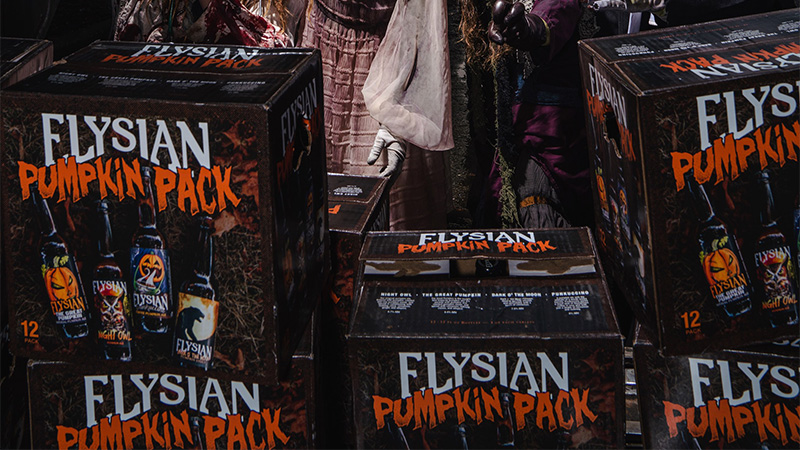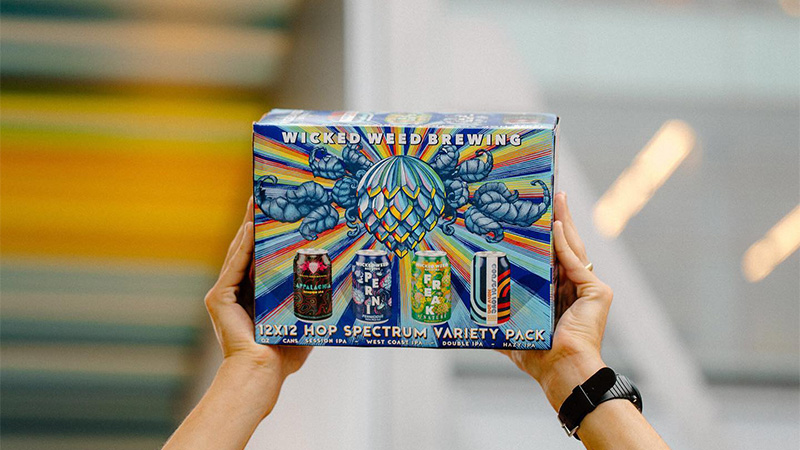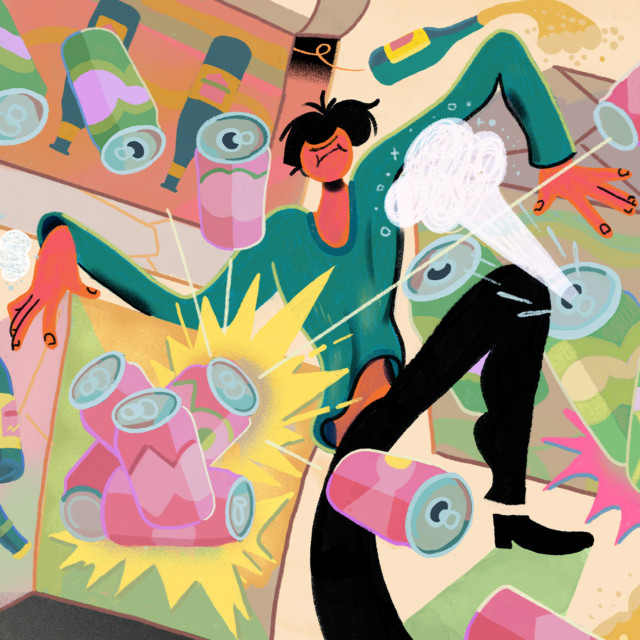In the earlier days of craft beer, novelty and discovery fueled consumer interest. These were not the ubiquitous macro lagers that had always been around. As more breweries hung their shingles, there were more options for curious imbibers to explore, often in styles they may have never encountered. Variety packs boxed that experience up, offering the opportunity to try new breweries, new beers, and new beer styles all in one handy purchase. However, with the fast and furious proliferation of craft breweries in the past five years or so, beer drinkers have more options, and are better versed in what they like.
“Five, 10 years ago, people got variety packs to discover new beers,” says Brewers Association chief economist Bart Watson. “That got put under a lot of pressure by the explosion in breweries, taprooms, and brewpubs.” Now, when you want to explore new beers, there’s often a brewery just as close as your local grocery store, where shelves hold variety packs.
(It’s important to note that when we talk about “craft beer” here, we’re not adhering to the Brewers Association’s definition of the term. According to the BA, a craft brewer produces 6 million barrels of beer or less annually, and less than 25 percent of the brewery is owned or controlled by an industry member that is not a craft brewer. Independent breweries often don’t have the means to produce the slick variety packs we see on supermarket shelves, with a few exceptions.)
So, how relevant are seasonal variety packs anymore? Do consumers care about them as much as they did 10, even five years ago?
A general look at Nielsen data for assorted craft beer packs from 2017 to 2021 paints an interesting picture. There are lots of spikes and drops, and quite a bit of plateauing. In some cases, there’s major growth, explained by the fact that the brewery was new and increased its own operation over five years, or, more currently, by the pandemic driving people back to grocery shelves to buy beer. And we expect what the future holds for on-premise will also be of interest.
This all balances out to make variety packs’ engagement drop undramatic but nonetheless discernible. It’s no mystery: Since 2017, we’ve only seen more taprooms opening (in 2021, the U.S. reached a record number of beer producers, exceeding 9,000), plus hard seltzer has cannibalized much of beer’s share.
On a broader scale, though, variety packs do still hold their own in sales, and provide enough value for breweries to continue producing them. To successfully engage consumers, however, many beer brands have changed their approaches.

Calendar-Based Variety Packs Are So Last Season
According to a 2018 Good Beer Hunting report, seasonal mix-packs’ stagnation isn’t new. At the time, IRI sales data showed major players like Sam Adams and Sierra Nevada leveling off or even dropping since 2013. But this didn’t kill the beer variety pack; rather, it catalyzed a pivot. Breweries recognized the waning interest in mix-packs tied only to a time of year, and seized upon the growing interest in mix-packs tied to specific beer styles and themes. While variety packs may never rebound to, say, 2014-level numbers, this recalibrated approach has helped them remain relevant and worthwhile.
“I don’t know that people are going hard for ‘spring beers’ or ‘fall beers,’” says Brewbound managing editor Jessica Infante of the season-to-style shift, adding: “Working with the calendar year is hard because the weather across the country is very different. … It’s hard to build a pack thinking about winter, cabin fever, and skiing when it doesn’t play in half the country.”
But if the IPA is a best seller, brewers have realized, it stands to reason that an IPA mix-pack should perform well. Watson says IPA mix-packs factor into variety packs’ growth in scan sales. We’re years past craft beer itself being novel enough to excite shoppers with eclectic assortments. Instead of gathering four different beers that maybe feel wintry, breweries are offering consumers the chance to explore styles vertically, buying a mix-pack with one or two varieties of a style they know they love, plus new ones to try.
“Right now, the cheat code is IPA,” says Good Beer Hunting news editor Bryan Roth. “The IPA-focused variety pack from Wicked Weed was brand new in 2021, and made almost $5 million.” That’s a strong debut for a variety pack, Roth says. The IPA pack in question, Hop Spectrum, sold almost the same amount as Oskar Blues’ well established CANundrum variety pack, which has been around since 2013, and was Wicked Weed’s number-two SKU in 2021, just behind its Pernicious IPA.
Of course, beer is inherently seasonal. The shift from mix-packs tied to the calendar to mix-packs tied to styles or themes can sometimes be nearly undetectable. Take Elysian Brewing’s Pumpkin Pack. It hits shelves right ahead of autumn, and consists of a beer obviously linked with fall. The main driver, however, is the style.
“It’s something Elysian has been doing for a long time, leaning into pumpkin beers,” Roth says. “They planted a flag; they want to own that time of the year for pumpkin beer. … There’s seasonality because it’s fall, but the pack also offers four different beers [within the pumpkin style], so there’s an excitement to it.”
It’s a nuanced delineation, but the season-to-style shift in focus changes the narrative. Craft beer variety packs’ potential has shrunk, but the fact that they haven’t died out all together is presumably thanks to this gear change.
With its Pumpkin Pack, Seattle-based Elysian joins Schlafly as an early adopter of the style-over-season variety pack. Schlafly head of marketing Wil Rogers says Schlafly’s Stout Bout debuted in 2014. Back then, producing a variety pack concentrating on one style was uncommon.
“When [Stout Bout] first launched, I think people were pretty surprised to see a stout-only pack,” Rogers says. “In our market, we were one of the first to launch a style-specific pack, and with stouts, which can be polarizing.” Despite any raised eyebrows, Stout Bout performed well out of the gate, and Rogers says “word got out”; the following year, Stout Bout sold incredibly well. It returns each year in the winter because most people reach for stouts in colder weather, but more than a season, this pack is about a beer style for which Schlafly has long been known. The St. Louis brewery has a popular Stout & Oyster Festival every March. Rogers says a staple of the event is a trial tent, where people can try experimental Schlafly stouts featuring everything from chocolate-cherry to horseradish. Favorites from each year’s fest inform the following Stout Bout curation.
Style-focused packs like Pumpkin Pack and Stout Bout achieve one of the main benefits of mix-packs for breweries, with more fine-tuned control than random seasonal assortments. The variety pack attracts consumers with the promise of a style they like, plus at least one or two beers they’re likely familiar with. Then, in that pack, they’ll try new-to-them beers, creating a low-stakes form of testing for the brewery. Elysian anchors the Pumpkin Pack with the Night Owl pumpkin ale; Schlafly maintains its classic Oatmeal Stout with a more recent staple, the Mexican Chocolate Stout, and lets customer voting inform the other two rotating additions. Schlafly harnessed the casual crowd-sourcing of each year’s Stout & Oyster Festival and started including postcards for Stout Bout buyers to vote on what would make it into the following year’s pack; 2021 saw the first Stout Bout with a QR code for voting. Rogers says the feature is a hit, that people love being heard and feeling part of the pack’s curation.

But Seasonal Variety Packs Haven’t Totally Left the Chat
While IPA, stout, and other popular styles are finding success in mix-pack form, there are a few exceptions to the season-to-style curation shift. Some breweries can parlay their reputations into sustainable engagement even for calendric packs. Breweries that are household names or have cult followings in the craft scene still find value in variety packs where the only common bond for the beers inside is a holiday or time of year. An obvious example is the Sam Adams holiday pack, which debuted in 2010 as the “Winter Classics Variety Pack” and is now called Beers for Cheers. 2021’s iteration featured the Boston Lager, a white ale, an IPA, a porter, a winter lager, and, famously, the return of Old Fezziwig old ale. Schlafly, too, has a season-specific pack in addition to its style-specific pack. The Patio Pack appears for summer with weather-appropriate brews like a raspberry hefeweizen and a hoppy lager.
Tröegs packages its cachet in variety packs that read like greatest-hits albums. Every season, the brewery releases an “Anthology Sampler,” the contents based on its most beloved beers of winter, spring, summer, and fall. Jeff Herb, marketing communications coordinator, says the holiday-centric Most Wonderful Beer of the Year Variety Pack was born in 2018. It includes Tröegs classics like the Mad Elf holiday ale, Perpetual IPA, Troegenator Double Bock, Blizzard of Hops Winter IPA, and DreamWeaver Wheat alongside the Grand Cacao Chocolate Stout, which launched in packs in 2020. This pack is less about testing experimental brews each year and more about combining established favorites in one box.
24 Beers of Cheer is another holiday-specific pack, but one used to gather an entire portfolio of breweries’ seasonal favorites. It’s from the Brewers Collective, AB InBev’s craft business, rounding up AB InBev-owned breweries like 10 Barrel, Goose Island, Elysian, Kona Brewing Co., and Widmer Brothers. Because this pack functions like a mixtape, the goal is to actually squeeze in as many styles as possible to demonstrate the Brewers Collective’s range.
“With 24 Beers of Cheer being centered around holiday occasions, where family and friends are getting together to celebrate, we really wanted to put a wide variety of beer styles and flavor profiles together in one pack,” says AB InBev’s Master Cicerone and senior educator Ryan Daley. Since the main theme of this pack is gathering, it’s a good way to ensure the different beer tastes in any room are satisfied.
Because it’s from a collective, 24 Beers of Cheers also accomplishes variety packs’ familiarity-plus-experimentation appeal on two fronts. Daley says 2021’s pack was the most ambitious iteration yet, with 24 beers representing 13 styles and seven breweries. For both beers themselves and breweries, buyers recognize their favorites but are bound to discover new options, too.
For Plenty of Craft Beer Drinkers, Variety Is Still the Spice of Life
Because of the ubiquity of taprooms and the ease of accessing craft beer just about anywhere, in addition to the rise of other categories like hard seltzer, craft beer variety packs will probably never again engage consumers the way they did in 2012, or even 2017 — the more options readily available, and the less novel craft beer becomes, the less people rely on mix-packs for discovery. However, breweries with the means have proven the consumer response is still worth the effort to produce them. Whether it’s cashing in on the soaring popularity of IPA or, for a select few, boxing your own storied reputation in a holiday or summer assortment, the right formula can still generate excitement, attract buyers with classics, and test new brews.
The basic concept of variety, after all, still intrigues craft beer drinkers. It’s why smaller producers utilize it, even when consumers are, in fact, buying right from the taproom. In Brooklyn, Finback Brewery’s “Mix Up” allows customers to combine pilsners and IPAs, and Talea Beer Co. takes the style-focused approach with a Sour Pack and an IPA pack. Think about bottle shops that put out can holders so shoppers can make their own variety packs from individually sold brews. Variety, itself, still engages in a scene built on thousands of producers creating their own examples of hundreds of different styles. The category may continue to shrink, but until the value of promising consumers beers they love plus new beers they can try disappears, mix-packs will survive.
This story is a part of VP Pro, our free platform and newsletter for drinks industry professionals, covering wine, beer, liquor, and beyond. Sign up for VP Pro now!
